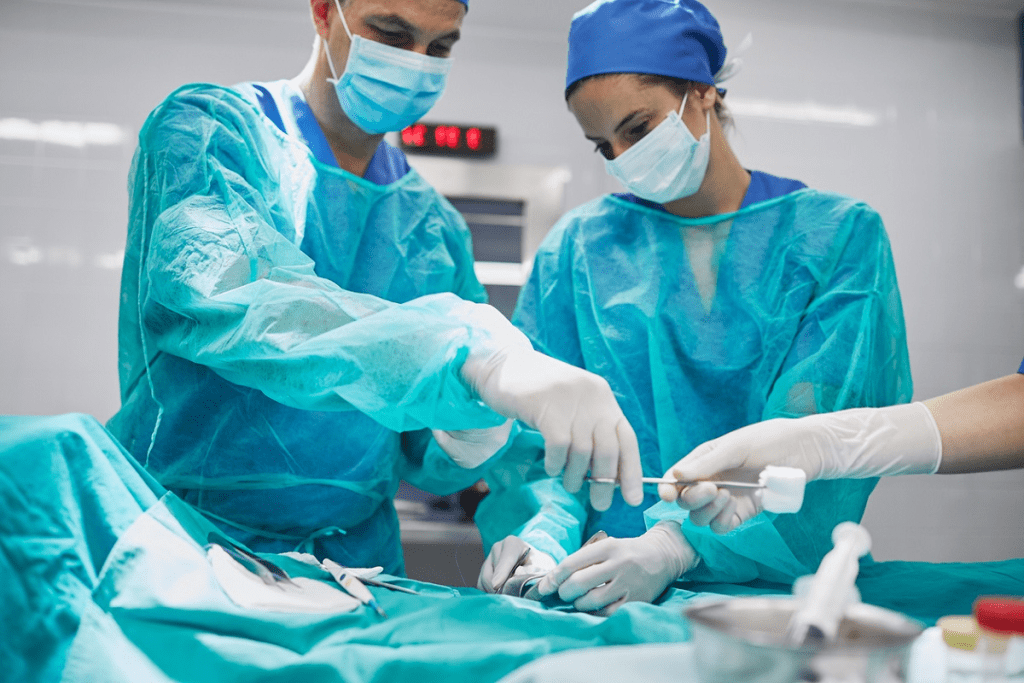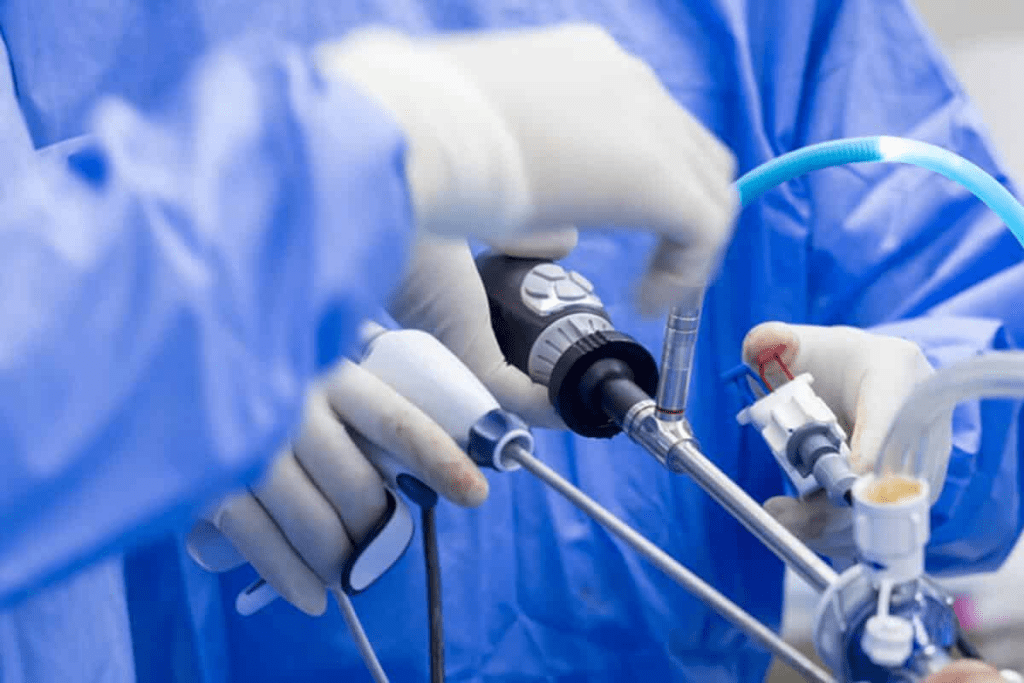Gastrointestinal (GI) surgeries are key to treating many digestive health problems. Laparoscopic cholecystectomy is the most common, with over 1 million done each year in the US.

GI surgeries help with gallstones and gallbladder inflammation. Laparoscopic cholecystectomy is very important in today’s surgery. There’s also a big need for bariatric surgery, like a gastric sleeve or sleeve gastrectomy, for weight loss surgery.
Key Takeaways
- Laparoscopic cholecystectomy is the most common GI surgery.
- Over 1 million laparoscopic cholecystectomy procedures are performed annually in the US.
- Bariatric surgery is increasingly in demand for weight loss.
- Gastric sleeve and sleeve gastrectomy are common types of bariatric surgery.
- GI surgeries are key to treating various digestive health issues.
The Landscape of Gastrointestinal Surgeries

Gastrointestinal (GI) surgeries cover a wide range of treatments. They are key in modern healthcare. They help with many digestive system issues.
Definition and Types of GI Surgical Procedures
GI surgeries are medical treatments for the GI tract. They include:
- Diagnostic procedures: Such as endoscopies and biopsies.
- Therapeutic procedures: Including surgeries like gastric bypass surgery and gastrectomy.
- Minimally invasive surgeries: Procedures that reduce recovery time and scarring.
- Emergency surgeries: Surgeries required to address acute conditions like appendicitis.
These types show the variety of GI surgeries. Each has its own use and benefits.
Global Prevalence and Statistical Overview
GI surgeries are common worldwide. Millions are done every year. Conditions like gallstones, obesity, and colorectal diseases lead to these surgeries.
Some important stats are:
- There has been a big increase in bariatric surgeries due to obesity.
- A lot of laparoscopic cholecystectomies for gallbladder removal.
- More colorectal surgeries for cancer and other issues.
The Shift Toward Minimally Invasive Techniques
There’s a big move to minimally invasive surgical techniques. These include laparoscopic and robotic surgeries. They have many benefits, like shorter recovery times and less pain.
The advantages of these surgeries are:
- Shorter hospital stays.
- Less risk of complications.
- Improved cosmetic outcomes.

As technology gets better, GI surgeries will keep improving. This will help patients more and treat more conditions.
Laparoscopic Cholecystectomy: Leading the GI Surgery Statistics
Laparoscopic cholecystectomy is a key part of gastrointestinal surgery. It uses a minimally invasive method to remove the gallbladder. This approach has changed how we treat gallbladder diseases.
Understanding Gallbladder Disease and Indications for Surgery
Gallbladder disease, often caused by gallstones, can lead to serious problems if not treated. Symptomatic gallstones are a main reason for this surgery. We also consider surgery for those with recurring gallbladder inflammation or other issues.
Choosing surgery involves careful evaluation, including imaging tests like ultrasound and CT scans. Early intervention helps avoid serious complications like gangrene or perforation.
The Laparoscopic Cholecystectomy Procedure Explained
This surgery is done under general anesthesia. The surgeon makes small incisions in the abdomen. A laparoscope and tools are inserted through these incisions.
The surgeon then dissects the gallbladder from the liver and clips and cuts the cystic duct and artery. Intraoperative cholangiography might be used to see the bile ducts and check for stones.
Why It’s the Most Common Abdominal Surgery in America
Laparoscopic cholecystectomy is popular because it’s minimally invasive. It causes less pain and faster recovery than open surgery. Its high success rate and low risk of complications make it the top choice for both doctors and patients.
- Reduced postoperative pain
- Shorter hospital stay
- Quicker return to normal activities
- Less risk of complications
Recovery Timeline and Post-Operative Care
Recovery from this surgery is quick. Most people can get back to normal in a week. Pain management is key, with most needing only oral pain relievers.
We recommend a gradual return to normal diet and avoiding heavy lifting or strenuous activities for a few weeks. Regular follow-up appointments help monitor healing and address any concerns.
Bariatric Surgery: The Growing Field of Weight Loss Procedures
Obesity is a big problem worldwide, and bariatric surgery is a key solution for weight loss. The need for effective weight loss methods is growing fast.
The Rise of Obesity and Surgical Interventions
Millions of people are affected by obesity, leading to serious health issues. These include diabetes, heart disease, and some cancers. Bariatric surgery is a powerful tool for weight loss and improving health.
Studies show bariatric surgery helps with weight loss and health. For example, a study on PubMed Central shows its benefits in managing obesity and related health problems.
Sleeve Gastrectomy: The Most Popular Bariatric Procedure
Sleeve gastrectomy, or vertical sleeve gastrectomy (VSG), is the top bariatric surgery worldwide. It removes most of the stomach, leaving a narrow “sleeve” for food. Its popularity comes from its effectiveness and fewer complications.
Gastric Bypass: The Gold Standard Comparison
Gastric bypass surgery, or Roux-en-Y gastric bypass, is seen as the best bariatric surgery. It makes a small stomach pouch and reroutes the small intestine. Gastric bypass is known for its weight loss and health benefits. Sleeve gastrectomy is more common now, but gastric bypass is key for those needing more weight loss.
Emerging Trends in Bariatric Surgical Techniques
Bariatric surgery is getting better with new techniques. Robot-assisted surgery and single-incision laparoscopic surgery are new trends. They promise less invasive procedures, faster recovery, and better patient satisfaction. As technology improves, bariatric surgery will become even more effective and accessible.
Other Common Gastrointestinal Surgical Procedures
Many surgeries are done to treat different GI problems. These surgeries help manage various diseases in the GI tract.
Appendectomy: Emergency and Elective Approaches
An appendectomy removes the appendix, often needed quickly if it gets inflamed. “The timely removal of an inflamed appendix is critical to avoid serious issues like perforation and peritonitis,” says experts.
While most appendectomies are urgent, some can be planned. The laparoscopic method is often chosen. It leads to smaller cuts, less pain, and quicker healing than open surgery.
Hernia Repairs: Inguinal, Ventral, and Hiatal
Hernia repairs fix bulges in muscles or fascia. Inguinal, ventral, and hiatal hernias often need surgery.
Modern techniques like laparoscopy and robotics are used. They reduce pain and speed up recovery. The choice depends on the hernia type and the patient’s health.
Colorectal Surgeries: From Polyp Removal to Cancer Resection
Colorectal surgeries range from removing polyps to cancer removal. These are key for managing colorectal diseases, including cancer.
Minimally invasive methods like laparoscopy and robotics are used. They aim to cut down recovery time and complications. The choice depends on the condition, disease extent, and patient health.
Specialized High-Volume Center Procedures
Complex GI surgeries, like some colorectal resections and gastrectomies, are best done at specialized centers. These centers have teams skilled in complex GI care, providing advanced treatment and possibly better results.
Patients get full care at these centers, including pre-op checks, surgery, and post-op support.
Conclusion: The Future of Gastrointestinal Surgery
Gastrointestinal surgery includes many procedures, like laparoscopic cholecystectomy and bariatric surgery. The move to minimally invasive methods has changed the game. It has made patients’ outcomes better and recovery times shorter.
The future of GI surgery looks bright, with new technologies on the horizon. Robotic-assisted procedures and better imaging are just around the corner. Bariatric surgery will also be key in fighting the global obesity problem.
Looking ahead, GI surgery will keep getting better. Advances in tech and techniques will lead the way. By understanding where GI surgery is now and where it’s headed, we see its vital role in better health and life quality.
FAQ
What is a laparoscopic cholecystectomy?
Laparoscopic cholecystectomy is a surgery to remove the gallbladder. It uses small incisions and a laparoscope.
Why is laparoscopic cholecystectomy the most common GI surgery?
It’s the most common GI surgery because it’s effective against gallbladder disease. It also has a short recovery time and fewer complications.
What is bariatric surgery?
Bariatric surgery is a group of procedures to help people lose weight. It changes the stomach and intestines.
What is the difference between sleeve gastrectomy and gastric bypass surgery?
Sleeve gastrectomy removes part of the stomach. Gastric bypass surgery makes a small stomach pouch and reroutes the intestines. Both aim to reduce weight but in different ways.
What is the recovery process like after laparoscopic cholecystectomy?
After laparoscopic cholecystectomy, you’ll need a few days to rest. You’ll also need pain management and follow-up care for a smooth recovery.
Are GI surgeries safe?
GI surgeries, like laparoscopic cholecystectomy and bariatric surgery, are safe when done by experienced surgeons. But, as with any surgery, there are risks and complications.
What are the benefits of minimally invasive GI surgeries?
Minimally invasive GI surgeries, like laparoscopic cholecystectomy, have many benefits. They include smaller incisions, less pain, shorter recovery times, and lower risks of complications.
Can bariatric surgery be performed laparoscopically?
Yes, many bariatric surgeries, including sleeve gastrectomy and gastric bypass, can be done laparoscopically. This reduces recovery time and scarring.
What are the indications for GI surgery?
The reasons for GI surgery vary. Common ones include gallbladder disease, obesity, appendicitis, hernias, and colorectal conditions.
How do I choose a surgeon for GI surgery?
When picking a surgeon for GI surgery, look at their experience and qualifications. Also, consider the quality of care at the hospital or surgical center.
References
- National Center for Health Statistics. (2020). Health, United States, 2019: With Special Feature on Health Care Expenditures. Retrieved from https://www.cdc.gov/nchs/data/hus/hus19-508.pdf
- Amin, N., & Varghese, J. (2018). Laparoscopic Cholecystectomy. StatPearls. Retrieved from https://www.ncbi.nlm.nih.gov/books/NBK448154/

